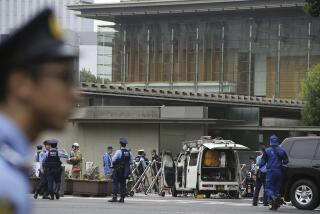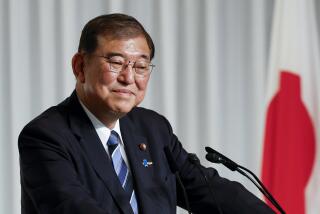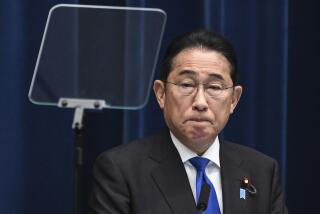Japanese Party Looks to New Faces to Bridge Generation Gap : Politics: A U.S. analyst predicts younger Liberal Democrat leaders will be easier for Americans to understand--but more challenging to deal with.
TOKYO â The recent ascension of Ryutaro Hashimoto, Koichi Kato and Taku Yamasaki to top posts in the leading Liberal Democratic Party is being hailed here as a critical generational shift that will begin to transform Japanâs oblique, inward-looking political culture.
âThis represents a new movement leading to a more assertive Japan,â said Yukio Okamoto, a political consultant and former Foreign Ministry official. âThese leaders are free from the shackles of a guilt complex about what Japan did in the past and are less inhibited . . . more nationalistic.â
Gerald Curtis, a Columbia University political science professor, said the new Japanese leaders will be easier for Americans to understand--but perhaps more challenging to deal with.
âWhat they have in common is that they all speak clearly, they know what they think and they are not shy about saying it--which will come as a surprise to Americans used to negotiating with Japanese who use vague and circuitous speech,â he said. âHopefully, this will reduce the miscommunication that has plagued this relationship, but it may be annoying to Americans who donât expect a hard line or having things thrown back in their face.â
Hashimoto, 58, the tough-talking trade minister who faced down U.S. Trade Representative Mickey Kantor in auto negotiations this year, was recently elected president of the LDP--Japanâs largest political party, which runs the government jointly with the Socialists and the New Party Harbinger.
Kato, 56, a former diplomat and an expert in agriculture and foreign affairs, was named LDP secretary general, the partyâs top executive.
And Yamasaki, 58, a defense specialist, will head the partyâs policy affairs research council.
The three men are considered startlingly young for Japanâs normally geriatric political leadership, and, particularly in Yamasakiâs case, they assumed power only after bruising generational battles with older politicians.
Yamasakiâs victory over an older rival demonstrated that the seniority system for winning party posts is breaking down, leading to more emphasis on pure competence, said Mitsuru Uchida, a political science professor at Tokyoâs Waseda University.
The younger leaders, schooled under the postwar democratic educational system, are also more willing to dispense with back-room dealings and operate in the open, Uchida said. Kato, now the partyâs policy chief, has pushed public debates among bureaucrats, politicians and citizens on deregulation issues. And for the first time, the LDP presidential election featured a TV debate between the two contenders.
âUntil now, Japanese politicians have been rather notorious for being faceless, but Hashimoto and the younger generation do have their own âface,â â Uchida said.
The result is more popularity with the public--an asset LDP officials are banking on as they face a general election in an atmosphere of widespread voter apathy.
In recent months, the Japanese public has expressed a decided distaste for old-style LDP politics by electing dark-horse mayors in Tokyo and Osaka and by handing unexpected victories to the opposition New Frontier Party in upper house parliamentary elections.
With electoral survival at stake, even the LDPâs influential elder statesmen, such as former Prime Minister Noboru Takeshita, supported the need to hand over power to more vigorous, youthful and telegenic leaders. (The elections are still unscheduled but may be called between now and April.)
Some here view the LDPâs leadership changes as a cynical ploy to project a fresh image onto old goods. Political commentator Minoru Morita called the changes atsugesho-- literally, âthick makeup,â being worn by the LDP to conceal party elders still calling the shots behind the scenes but savvy enough to realize that stepping forward would doom party chances for electoral victory.
The more optimistic analysts say the changes mark a genuine shift of power that could result in the most effective, dynamic leadership in years. Unlike Morihiro Hosokawa, the wildly popular prime minister from the Japan New Party who broke nearly four decades of LDP rule in 1993, Hashimoto and his team are said to possess two critical assets necessary to get things done in Japan: vast experience and good connections to the nationâs formidable bureaucrats.
Although they wonât say it openly, many of Japanâs bureaucrats are fed up with the amiable but lackluster Socialist prime minister, Tomiichi Murayama, and are eager to work with the LDP team. The LDP leaders are not above dressing down bureaucrats--the sometimes overbearing Hashimoto has publicly excoriated them, and Kato, in a fit of pique this year, banned finance bureaucrats from his chambers for dragging their feet on proposals to streamline the government.
But bureaucrats say they are gratified that the younger leaders can actually understand and contribute to the intricate policies under discussion and that they possess the political skills to push them through Parliament.
Cooperation between the political and bureaucratic worlds--a relationship that began breaking down when the LDP lost power, paralyzing national policy--promises to be revitalized, especially if the party reassumes majority control in upcoming elections, analysts say.
Hashimoto, a graduate of Keio University in Tokyo, studied the bureaucratic system at the feet of his father, a former finance official who helped craft Japanâs postwar recovery policies before running for office himself. Despite his relative youth, Hashimoto has won 11 elections and has served as minister of finance, international trade, transport, and health and welfare.
Kato, a Tokyo University graduate, is also the son of a former bureaucrat. He joined the Foreign Ministry as a China specialist before entering politics in 1972. Fluent in Chinese and English, Kato possesses an international outlook tempered by his conservative agricultural constituency.
Yamasaki is a protege of former Prime Minister Yasuhiro Nakasone and has served as defense chief and construction minister. He allied with Kato and Junichiro Koizumi to form the âYKKâ group representing younger LDP politicians opposed to Toshiki Kaifu, the prime minister from 1989 to 1991.
Despite the new leadersâ talent, the key question--What policies do they intend to pursue?--remains unanswered.
âMy guess is that they make for a more effective leadership, but what they want to do with their power is anyoneâs question,â said Curtis, the political science professor.
The new leaders are not expected to radically change national policies. For one thing, they are constrained by their coalition partners. And many say they define Japanâs national interests much as their elders did--based on good relations with the United States and China and a strong economic foothold in Asia.
Okamoto predicted that the âatmosphericsâ surrounding U.S.-Japan issues might change even if the substance does not. As one example, he said, elder leaders, more beholden to the United States, would have âtaken every measure possibleâ to calm public opinion over an Okinawa rape incident allegedly involving U.S. servicemen--whereas the current leaders are letting the storm ride itself out.
Despite predictions that Hashimoto and the others may be more prickly toward the United States, American officials say they are comfortable with the new leaders. And Hashimoto, in a recent interview with the Associated Press, defended the U.S.-Japan relationship as âthe most important one for usâ and rejected weakening ties with America in favor of Asia.
âWhen the U.S.-Japan Security Treaty is being firmly upheld . . . then and only then is it possible for [Japanâs ties with Asia] to expand,â he said.
More to Read
Sign up for Essential California
The most important California stories and recommendations in your inbox every morning.
You may occasionally receive promotional content from the Los Angeles Times.











